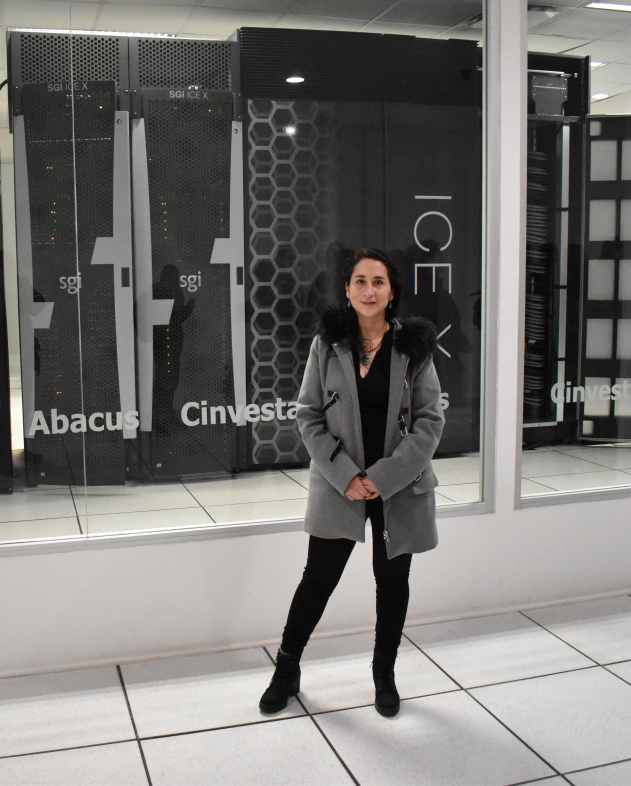
Estela Mayoral Villa is a researcher at the National Institute for Nuclear Research (ININ) and is a member of the Computational Fluid Dynamics group at the institute. She is an expert in multiscale numerical modelling of complex fluids. She has developed diverse computational methods for the analysis of complex systems applied in different areas in basic science as well as in industrial applications, especially in the design of specialised additives and prediction of physicochemical properties in enhance oil recovery. She has participated in projects focused on the modelling of structural materials and heat transfer in nuclear reactors as well as in environmental applications in the area of dispersion of contaminants in soil and water. She is currently engaged in the ENERXICO project applying multi-scale numerical modelling methodologies for the development of additives and materials for improved oil recovery and catalysis processes for heavy oil refining. She is also working in the development and implementation of numerical and optimisation methods for development of a fractured reservoir simulator.
In this interview, Estela shares her journey to becoming an expert in multiscale numerical simulation and talks about her experience working in the male-dominated industry.
How did you become interested in numerical simulation of complex systems?
My father was an engineer and professor of mathematics and physics. Since I was a child my interest in the natural sciences and my love of mathematics and art emerged. Above all, I had a curiosity to understand and be able to explain different phenomena of nature. I remember that my father used to emphasize the need for basic and applied research in the areas of energy, environment and health. When I started my high school studies, he had already taught me algebra, analytic geometry, differential and integral calculus. I really enjoyed participating in contests like the Math Olympics. At that time my interest in computer science emerged and I began to take programming courses and make my own computer programs. When I chose my career, I was faced with the tradeoff between my desire to study visual arts or science. Finally, I decided to study chemistry and soon move towards theoretical chemistry. During my master's degree I found in statistical mechanics and phenomenological analysis the possibility of combining various disciplines including my artistic concerns. Finally, in my Ph.D. I focused on the numerical and theoretical analysis of nonlinear systems studying thermodynamics of systems on the edge of chaos. When I finished the doctorate I was interested in using my knowledge in applied areas.
I started working in the industry research area applying computational modelling to the design of additives for different applications, particularly in coatings and enhance oil recovery. Later, when I started working at the ININ in the Computational Fluid Dynamics group, I became interested and developed further in the area of numerical modelling of complex fluids, and began to develop and implement different methodologies to solve problems applied in different areas of interest of my institution. Since then, I have been participating in different projects related to energy, environment and material design as well as in the prediction of thermodynamic properties of complex fluids.
What is your participation in the ENERXICO project?
In the ENERXICO project I carry out several activities applying and implementing different multi-scale numerical modelling methodologies for the development of additives and materials for improved hydrocarbon recovery and catalysis processes for heavy oil refining; as well as in the calculation of thermodynamic properties of these complex systems necessary to improve existing simulations. I also participate in the analysis and implementation of numerical and optimisation methods for developing test and benchmarks of the fractured reservoir simulator that is being developed.
As a woman, what is your experience working in the ENERXICO project?
Even though there are different manifestations of gender discrimination in the area of research and engineering, in my professional development and in particular in this project my experience has always been positive. The interaction with all my collaborators has always been one of respect and camaraderie. Since I developed my studies and later on during my professional experience, I was included without any restriction, discrimination or harassment by my colleagues. Most of my friends and coworkers are men with whom I share interesting discussions. I think that the main difficulty related to my gender has been in the external social environment and not in my work. Being able to work as a professional at the same time as being a mother, has made me take decisions that are often judged by sectors of society that cannot understand the motivation that leads a woman to pay the same attention to her professional life as her personal life. This is especially true in regard to the care, attention and time dedicated to children. I think it is in society as a whole where more work must be done to develop structures that allow women to continue participating in professional life with more flexible options.
Do you have any advice for women who are interested in the science and numerical simulation area?
I encourage all women who are interested in sciences, mathematics, engineering and computational sciences to enter these areas without any prejudice since I consider that change in the gender-related attitude in science and engineering will gradually be more inclusive when a greater number of women participate in these branches.
